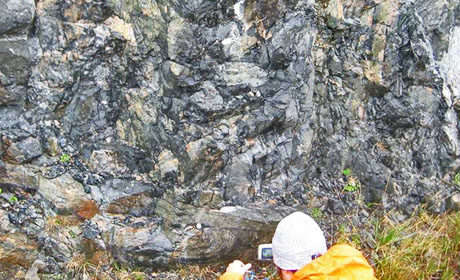Outer Isles Fault and Pseudotachylytes
North Uist, Outer Hebrides, Scotland

Pseudotachylytes are spectacular rocks formed by frictional melting. There are two geological processes are believed to be responsible – meteor impacts and large earthquakes.
The first significant descriptions of fault-related pseudotachylytes come from the Outer Hebrides. Here the Outer Isles Fault Zone cuts through Lewisian gneisses. Research by Rick Sibson in the early 1970s established the relationships between slip surfaces and veins of pseudotachylytes from which he was able to estimate the energy associated with earthquake faulting, together with the changes in stress during earthquakes.

The Outer Isles Fault clips on and off the east side of the Outer Isles. Some of the best exposures that can be used to put together a short tour are found on North Uist. The road cuttings on the A867 a few km WSW from Lochmaddy offer dramatic examples of thick pseudotachylyte breccias.
The gneisses here are highly shattered, cross-cut by black seams of glassy rock. Within the overall brecciated texture there are discrete slip surfaces – presumably the generation zones for the melt that formed by fast (10s m per second) fault motion and wing-cracks filled with glass.
To examine the patterns of anastomosing fault zones and to appreciate the range of fault rock types, it’s worth walking over the rough fells east of Burrival. Simple melt-generation surfaces with wing cracks are nicely displayed on Grimsay, especially on roadside outcrops along the southern part of the island’s loop road and in low slabs on the SE coast.
Text: Professor Rob Butler
Further reading:
Sibson, R.H. 1975. The generation of psudotachylyte by ancient seismic faulting. Geophysical Journal International 43, 775-794.- Original account of the patterns of pseudotachylyte on the Outer Isles and their relationships to fault surfaces, which goes on to examine earthquake mechanics.
Read online at the GJI Website (Fellows Only) (OpenAthens Account Required, find out more at the Library)
- Discussion of Sibson’s work in the context of the long-lived history of motion on the Outer Isles Fault.
Read online at the Wiley Online Library (Fellows Only) (OpenAthens Account Required, find out more at the Library)
Images copyright Rob Butler
